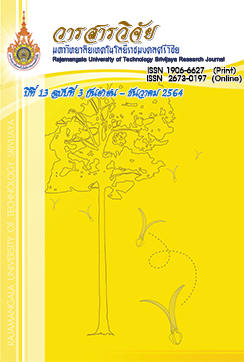Calcium Content, Physicochemical Quality and Sensorial Acceptability of Catfish Crispy Snack Fortified with Catfish Bone Powder
Keywords:
fish crispy snack, fish bone, calcium, catfishAbstract
The objective of this research was to study the quantity of catfish bone powder on the physical, chemical and sensory qualities of catfish crispy snack fortified with calcium from catfish bone powder as 0 (control), 10, 20 and 30%. It was found that an increase in catfish bone powder led to a decrease in hardness and moisture content, while swelling and calcium content increased. The catfish crispy snack without catfish bone powder contained 58.50 mg of calcium/ kg of sample (dry weight) while the one with 30% of catfish bone powder had a high calcium content, up to 8,930 mg of calcium/ kg of sample (dry weight). The sample fortified with 20% catfish bone powder was rated the best by panelists (p<0.05). But, when the chemical composition of the catfish crispy snack added 20% catfish bone powder was analyzed and compared with the control, it was found that the control had higher protein, fat, fiber and carbohydrate while ash was lower. It can be concluded that catfish crispy snack with catfish bone powder supplement can reduce the amount of by-product, and provide nutritional value for consumers who like to stay healthy.
References
AOAC. 2000. Official Methods of Analysis of the Association of Official Analytical Chemists. 15thed. Virginia: Association of Official Analytical Chemists, Inc.
Guillaumin, R. 1988. Frying of food: principles, changes, new approaches. pp. 28-112. In Varela, G. Bender, A.E. and Morton, I.D., eds. Kinetics of fat penetration in food. VCH-Ellis Horwood, Chichester, England.
Hemung, B. 2013. Properties of tilapia bone powder and its calcium bioavailability based on transglutaminase assay. International Journal of Bioscience, Biochemistry and Bioinformatics 3: 306-309.
Huda, N., Leng, L.L., Yee, C.X. and Herpandi. 2010. Chemical composition, colour and linear expansion properties of Malaysian commercial fish cracker (keropok). Asian Journal of Food and Agro-Industry 3: 473-482.
Jaturapucharporn, S. 2000. Using the shrimp wastes for supplementation of calcium in Kaou Greeap. Master of Science Program in Science Education, Kasetsart University. (in Thai).
Lachmann, A. 1969. Snack and fried product. Noyes Data, New Jersey.
Laksana, C. 2012. Use of selected natural calcium sources for calcium enrichment of crisp rice. KKU Science Journal 40(4): 1214-1224.
Mahnaz, N., Huda, N. and Ariffin, F. 2017. Development of calcium supplement from fish bone wastes of yellowfin tuna (Thunnus albacares) and characterization of nutritional quality. International Food Research Journal 24(6): 2419-2426.
Muninnopamas, W. and Phalachai, P. 2015. Development on garlic black pepper flavoured palaw keropok. RMUTSV Research Journal 7(1): 15-27. (in Thai).
Nurul, H., Ang, L.L., Chung, X.Y. and Herpandi. 2010. Chemical composition, colour and linear expansion properties of Malaysian commercial fish cracker (keropok). Asia Journal of Food and Agro-Industry 3(5): 473-482.
Nurul, H., Boni, I. and Noryati, I. 2009. The effect of different ratios of Dory fish to tapioca flour on the linear expansion, oil absorption, colour and hardness of fish crackers. International Food Research Journal 16: 159-165.
Panyakhamlerd, K., Chaikittisilpa, S., Taechakraichana, N. and Limpaphayom, K. 1997. Calcium and postmenopausal osteoporosis. Chulalongkorn Medical Journal 41(11): 845-859. (in Thai)
Saah, N., Chedoloh, R. and Adair, A. 2015. Production and properties of fish crackers substituted with soybean meal. Journal of Community Development and Life Quality 3(3): 351-359.
Sihamala, O. 2002. Impovment of nutritional quality and shelf-life of fish crispy. Master of Science Program in Science Education, Chiang Mai University. (in Thai).
Sukjuntra, J. 2016. Development of traditional food from sago starch : frozen palaw keropok. Burapha Science Journal 21(2): 17-30. ( in Thai)
Suriya, P., Thamaragsa, N., Kaewtein, S., Pocarat, R. and Arkanit, K. 2011. Product development of Burma bean chip, pp. 276-283. In Proceedings of the 2nd MJU-Phrae National Research Conference. (Vol. II,). Book of abstracts, Phrae. (in Thai)
Thai Community Product Standards. 2011. Crisy snack, Khaogriba. Thai Industrial Standards Institute, Ministry of Industry, Bangkok. (in Thai)
Tongdang, T., Meenun, M. and Chainui, J. 2008. Effect of sago starch addition and steaming time on making cassava cracker (keropok). Starch/Stärke 60(10): 568-576.
Zhu, K. and Prince, R. 2012. Calcium and bone. Clinical Biochemistry 45(12): 936-942.
Downloads
Published
How to Cite
Issue
Section
License
The content and information in the article published in Journal of Rajamangala University of Technology Srivijaya It is the opinion and responsibility of the author of the article. The editorial journals do not need to agree. Or share any responsibility.







